YEAR-WISE EVICTION
These graphs derived from the database
depicts a trend in the number of people who departed from Bhutan in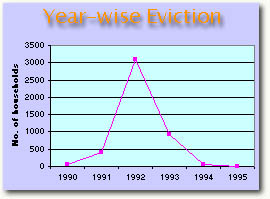 conformity with the ground reality of the government repression during the
periods indicated.
conformity with the ground reality of the government repression during the
periods indicated.
Observation
There is a considerable increase in the number of people in 1991 as compared to 1990 and the number of people leaving Bhutan is the maximum in 1992. The number sharply declines in 1993 and the trend follows in 1994.
Findings – Reasons and Justification
In 1990, the government repression escalated around the time the mass peaceful demonstration took place in southern Bhutan. People leaving Bhutan in 1990 include human rights and political activists and influential people in the villages who were alleged by the government authorities of being involved in the movement. These people left the country fearing persecution or because of continuous harassment.
But in 1991, during the 70th session of the National Assembly, the Royal Government resolved to evict any citizens, whom it termed as 'anti-nationals', i.e people who supported or were involved in the pro-democracy movement of 1990. Having legitimized eviction, it introduced the so called 'voluntary migration forms' or VMF, and began a systematic eviction of southern Bhutanese . Hence the increase in the number of people leaving Bhutan. This calculated campaign of the government to evict the southern Bhutanese climaxed in 1992. The year saw the maximum number of people leaving Bhutan. It sharply decreased in 1993 and the trend followed in 1994. This is so because international pressure had begun to increase particularly after the visit of Amnesty International to Bhutan in January 1992 and after the UN High Commissioner for Refugees established camps in Southeast Nepal and began providing humanitarian assistance to refugees from June 1992. The other reason for this decrease is also because Bhutan government had evicted most of the population it had ostensibly targeted, by the end of 1992. The strategy of the government to uproot its southern citizens is also evident from the then Deputy Home Minister Dago Tshering's pronouncement in the 66th session of the National Assembly that there were over one hundred thousand non-nationals in the country. This figure, which roughly corresponds to people evicted from Bhutan, establishes that there was a pre-designed strategy of the government. The reality is in sharp contrast to this governmental propaganda. The records of database proves that the refugees in the camps of Nepal are victims of arbitrary deprivation of their nationality as it is evident from the fact that 99.83 percent of the refugee population are in possession of incontrovertible evidences of Bhutanese origin and nationality. The remaining 0.17 percent have letters of certification from their respective village representatives certifying their Bhutanese origin.
EVICTED AFTER BEING FORCED TO SIGN THE 'VOLUNTARY MIGRATION FORM' [VMF]
Bhutan government's central argumentl in its campaign against the return of the refugees to Bhutan is its claim that many people in the refugee camps have voluntarily denounced their Bhutanese citizenship to emigrate elsewhere prior to leaving Bhutan. This is the most contentious issue in the Bhutan-Nepal bilateral talks where Bhutan insists that by the country's citizenship laws these people cannot return. This posture of Bhutan needs to be judged against the backdrop of circumstances under which the people were forced to sign the so called 'Voluntary Migration Forms' and Bhutan government's calculated policies to evict the southern Bhutanese.
Let's first look at what the refugees themselves say….
"The inmates at the school turned detention centre at Damphu were coerced to give the names of the prominent people of the villages and guide the soldiers to their houses. The soldiers raided these houses, arrested the household heads and tortured them at the detention centre until they signed the so called 'voluntary migration forms'. In this manner, a total of 191 households from Dunglagang block were driven out of the country."
Birkha Bahadur Gurung, 60, Former Deputy Block Headman, Chirang District.
"I was called to the Dungpa's office where he inquired about my family as he knew about my son's involvement in the peaceful demonstration. He ordered me to write an application stating that I wanted to leave the country. I denied. Then two policemen caught hold of my hair and asked me to sign. When I still refused, one police officer roughly caught hold of my right hand and dipped my thumb into an inkpad and put my thumb print signature at the bottom of a white paper. The Dungpa seized my Citizenship card and land tax receipts. Then I was forced to sign on four forms and told to leave the country within two days."
Dirga Singh, 59, Samchi District.
On the fifth day, the soldiers came to the prison cell and began intimidating me to write the application. Tired and exhausted, I was unable to bear anymore of the torture and I wrote down the application. Soon after that I was released. After seven days, a group of police personnel came to my house to summon me to the district office in Sarbhang. There they had the 'VMF' filled and forced me to sign a document, the content of which I did not understand. Out of sheer fear I signed it They gave me a very small amount of money. While receiving the money, I was asked to smile and say that I was leaving the country on my own free will, facing a video camera. When I refused, the policemen beat hard on my back. Out of extreme fear, I complied to the order as the Dzongah and the Dungpa watched the scene mockingly. Then the Dzongdah Penjor Dorji, ordered me to leave the country within five days.
Chudamuni Adhikari, 49, Sarbhang.
These statements explain for themselves as to how the people were forced to sign the so called 'VMF'.
These facts – that the contents of the documents on which they signed was illegible to them; that threat, intimidation and torture was used as a tool to make these people sign those forms; that there was no natural calamities, famine or war which made them leave their homes; that they now live as refugees and that they want go back to their homes in Bhutan – proves that the refugees are not voluntary emigrants but victims of forced eviction by the Bhutanese government authorities.
The government's insistence in bilateral negotiations with Nepal that Bhutan's citizenship law do not allow people who have left the country to return, is totally farce. First, because they did not leave the country on their own will. They were forced out of Bhutan. Secondly, Bhutan Citizenship Act 1977 states that 'if anyone, whether a real Bhutanese or a foreigner granted citizenship, applies for permission to emigrate during times of crisis such as war, the application shall be kept pending until normalcy returns'. Given this provision, the government cannot give permission for emigration because by the King's own statements during his tour of southern districts in 1993, as reported in the Kuensel, March 6, 1993, the country was going through times of difficulty and trouble. Thus the question of out migration during that period of early 90s does not arise. Hence it demerits Bhutan government's argument that the people in the camps in Nepal are voluntary emigrants.
The survey of 4553 households indicate that 57 percent of the refugee population were forced to sign the so called 'VMF'. The findings depicted by the following graphs and charts authenticate the stage-managed operation of the Royal Government of Bhutan to force the people to sign the 'VMF'.
Observations
- a. People leaving Bhutan
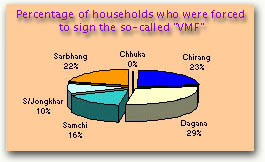 after being
forced to sign the 'VMF' in the district of Sarbhang is
after being
forced to sign the 'VMF' in the district of Sarbhang is The number of people leaving Bhutan after being forced to sign the 'VMF' in 1992 is the greatest in Dagana and less in Samchi, while in 1993, the reverse of the same is seen. Similar situation is seen in Chirang and Samdrupjongkhar .
comparatively less than those who were made
to do so, where as almost all the of people in Dagana were forced to sign the 'VMF'.
Similar situation is also seen when we compare Samchi and Chirang.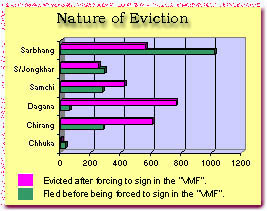
b.There is maximum number of people who were forced to sign the 'VMF' in the districts of Dagana and Chirang while the reverse is seen in Samdrupjongkhar and Samchi.
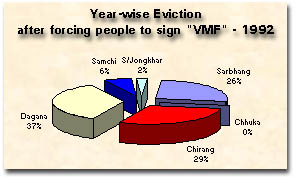
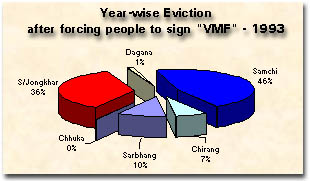
Findings - Reasons and Justification
The geographical location of the districts and the period of expulsion have become a significant factors in determining the nature of eviction, in relation to the pattern used by the authorities in compelleing families to sign the 'VMF'.
- The districts of Sarbhang and Samchi lie adjacent to Indian border, a relatively safer place then, and the people could cross over within hours. Hence larger number of people could flee away before the authorities could force them to sign the 'VMF'. But for the people coming from the districts of Dagana and Chirang, which lies in the interior, it would take days for them to come to Indian border passing through various check points on the way. Hence, the maximum number of people in Dagana and Chirang were forced to sign the 'VMF'
- Another determinant of the district-wise contrast in the number of people forced to sign the 'VMF' is the tactics of government repression. We can see that in 1992, more people in the districts of Dagana and Chirang were forced to sign the forms where as in 1993, more people in the districts of Samdrupjongkhar and Samchi had to leave Bhutan after signing the 'VMF'. This is so because, the government was building fear psychosis in the people to make them leave their homes in Bhutan as it was convenient for it make the people in the interior part of the country to comply to signing the 'VMF'. As for Sarbhang, the situation was different. The peaceful demonstration of 1990 was held in a massive scale there and the place saw maximum of arrests and imprisonment as the government heavily deployed military to crush the uprising. Hence, we see that more people in Sarbhang were forced to sign the 'VMF' in 1991 as compared to 1993.